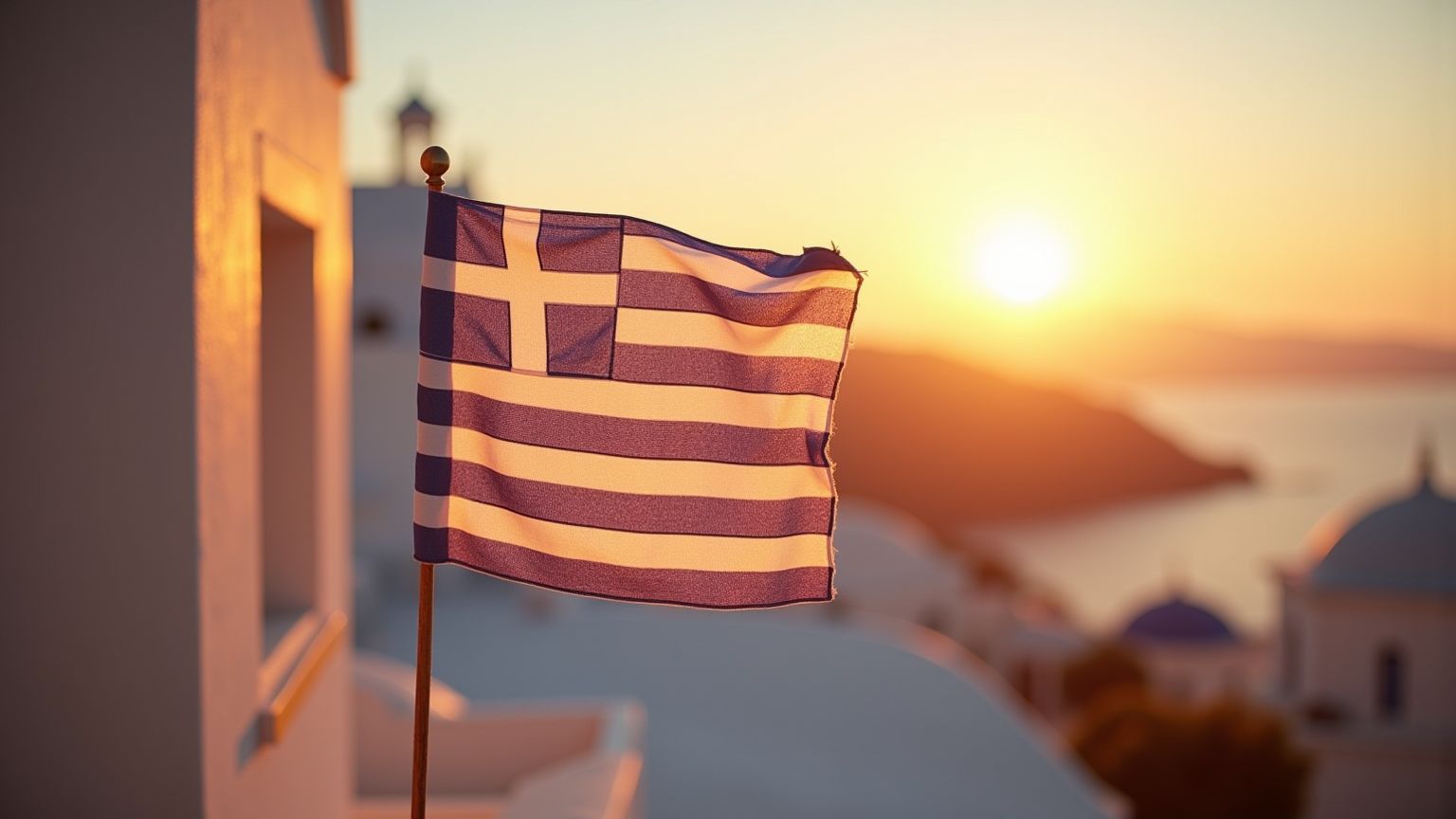The Story Behind Greece Colors. Blue and White: History, Symbolism and Where to See It
After spending over twenty years guiding curious souls through Greece's breathtaking landscapes, I've lost count of how many times I've been asked: "So why is everything blue and white?" It's no wonder people ask – these Greece colors have become the country's unofficial signature, splashed across everything from fancy travel magazines to the local Greek takeout joint in your hometown. But trust me, there's more to these Greece colors than meets the eye.

The Origins: Busting Those Tourist Tall Tales
First things first, let's clear something up. Many folks step off the plane expecting to find a country that's been decked out in blue and white since Zeus was throwing lightning bolts. Not quite.
The iconic Greece colors scheme we all know and love is actually pretty modern in the grand scheme of things, mostly taking hold in the 20th century. My grandfather used to tell me stories about watching our island's appearance transform throughout his lifetime. The real story is a fascinating cocktail of practical island living, political maneuvering, deep-rooted superstitions, and yes – a brilliant marketing strategy.
Practical Beginnings: Why White Makes Right
Long before tourists were hunting for the perfect Instagram backdrop, islanders were slapping whitewash on their homes for a dead simple reason: survival in the Mediterranean heat.
White reflects the blazing summer sun, turning houses into natural air conditioners when temperatures soar. The whitewash itself came from lime and offered some impressive benefits:
• Kept bugs and bacteria at bay (nature's disinfectant!)
• Shrugged off rainwater like a champ
• Cost practically nothing to make
• Created community bonding during annual repainting rituals
My grandmother's eyes would light up describing the springtime whitewashing festivals. "The whole village smelled of lime," she'd say, "and by sunset, our hands were raw, but every wall gleamed like fresh snow."
Adding Blue to the Mix: Superstition Meets Style
That gorgeous blue that makes the Greece colors palette complete isn't just pretty – it's purposeful. The deep cobalt shade (locals call it "kyanos") has ancient roots in Byzantine art and Orthodox tradition, where it represented heaven and divinity.
For everyday buildings, the blue touches served multiple clever purposes:
• The natural pigment actually repelled insects (those mosquitoes never stood a chance!)
• Many believed blue doorways confused evil spirits (they apparently can't tell blue from water)
• The shade perfectly mirrored the surrounding Aegean sea and sky
• The contrast with bright white created a visual pop that simply looks stunning
My great-aunt on Paros was fanatical about her door being the exact right shade of blue. "This blue protected my mother through the occupation," she'd insist, "and it will protect us too." These aren't just Greece colors – they're talismans.
The Political Plot Twist: Nation-Building Through Paint
Here's something that surprises most visitors: those picturesque Greece colors became standardized partly through government decree. During the military junta (1967-1974), regulations mandated blue and white paint schemes across many island regions.
This wasn't just architectural micromanagement – it was nation-branding. Those Greece colors matched the national flag perfectly, drumming up patriotic sentiment during politically turbulent times. The military government essentially created visual unity that reinforced national identity while simultaneously crafting an instantly recognizable "Greek look" for tourism.
When democracy returned, communities kept the Greece colors going strong. By then, they'd become both a beloved tradition and a serious tourism magnet. It's a remarkable example of how something imposed can transform into something treasured.
Regional Rainbow: Not All of Greece Got the Blue-White Memo
As someone who's trudged through every nook of this gloriously diverse country, I make sure my tour groups understand that Greece colors vary dramatically depending on where you wander. The architectural diversity here will blow your mind.
The Cycladic Islands: Blue & White Heaven
The Cyclades island group delivers those classic Greece colors in spades. Santorini, Mykonos, Paros, and Naxos are where you'll find the postcard-perfect scenes that probably lured you here.
Santorini is the undisputed champion of the Greece colors aesthetic. Those white-snow buildings tumbling down the volcanic caldera, punctuated by blue domes that seem to capture pieces of the sky – it's magic made real. After guiding thousands through Oia's winding pathways, I can confirm: no photograph has ever truly captured it.
Mykonos takes the Greece colors game to another level with its deliberately confusing white maze (designed to frustrate pirates) anchored by bright blue doors and shutters. Little Venice, where white walls seem to rise directly from the azure Aegean, demonstrates these Greece colors in perfect harmony.
Beyond Blue and White: Greece's Colorful Surprises
Venture beyond the Cyclades, and Greece reveals a much richer color palette than the famous Greece colors you see on postcards:
• The Ionian Islands flaunt their Venetian heritage with buildings in sunset oranges, honey yellows, and blush pinks. Wander through Corfu Town, and you'll wonder if you've somehow teleported to Italy.
• Rhodes and Kos in the Dodecanese blend Byzantine, Ottoman, and Italian influences. Rhodes' medieval Old Town showcases honey-colored stone that tells tales of Crusader knights and Ottoman sultans.
• Northern Greece embraces rugged stone architecture with wooden balconies. The 46 stone villages of Zagori seem carved from the mountains themselves – not a speck of those famous Greece colors in sight!
• The Pelion Peninsula flaunts mansion houses with slate-gray walls and terracotta roofs, nestled in forests that tumble nearly into the sea.
• Athens itself is a magnificent architectural mess spanning 3,000 years – ancient marble, Ottoman influences, neoclassical grandeur, and concrete apartment blocks all competing for attention.
The Tourism Effect: Turning Greece Colors into Cold, Hard Cash
By the 1970s, as charter flights started dumping tourists onto Greek runways, the blue and white Greece colors scheme became marketing gold. Tourism pamphlets plastered those Greece colors everywhere, creating a self-reinforcing cycle.
I've watched this play out on my home island, where buildings along main tourist drags receive obsessive attention to their Greece colors while houses a block away might sport peach, yellow, or whatever color was on sale at the hardware store.
The Greek Tourism Organization weaponized these Greece colors internationally, transforming them into Greece's visual signature. The campaign worked spectacularly – today, even airport duty-free shops know that slapping those Greece colors on a bottle of olive oil makes it fly off the shelves.
Where to Experience the Ultimate Blue-White Greece Colors Experience
After decades showing folks around, here's where I recommend experiencing the most stunning examples of the classic Greece colors:
Santorini – Oia and Fira offer those dramatic cliffside scenes with the iconic blue domes against whitewashed buildings. Pro tip: hit these spots at sunrise before the cruise ship crowds arrive.
Mykonos – Skip the packed main town and explore Ano Mera or the windmills at Alefkandra for those Greece colors without the chaos. Little Venice delivers those classic blues and whites right at the water's edge.
Paros – Naoussa fishing village and hillside Lefkes showcase authentic Greece colors with breathing room. The marble-paved alleys of Lefkes, with brilliant white walls and sky-blue accents, steal my heart every damn time.
Milos – The fishing hamlet of Klima features unique "syrmata" – boathouses with living quarters above, painted in vibrant Greece colors. These open directly into the sea, creating an unforgettable scene.
Sifnos – The medieval village of Kastro, with its white cubic houses huddled around ancient defensive walls, offers perhaps the most authentic Greece colors experience without the Instagram influencer traffic jams.
Preservation Headaches: Keeping Tradition in the Modern World
As someone neck-deep in local preservation efforts, I've seen the struggles to maintain these architectural traditions. The Greece colors might be iconic, but they're not always practical in the 21st century.
Traditional whitewash demands yearly maintenance – a back-breaking process many property owners now skip in favor of modern, longer-lasting paints. Problem is, these synthetic alternatives don't "breathe" like lime wash, can trap moisture, and lack the subtle texture variations that give traditional Greece colors their depth and character.
As families modernize homes with air conditioning units, satellite dishes, and solar panels, maintaining those picture-perfect Greece colors becomes tricky. Many island municipalities now enforce strict building codes in historic districts, specifying acceptable Greece colors and materials to preserve the character that keeps tourism dollars flowing.
The Soul Behind the Surface: Greece Colors as Philosophy
After years immersed in these communities, I've come to see the Greece colors as more than just pretty paint choices – they embody fundamental aspects of Greek identity and worldview.
The blinding white speaks to a Greek appreciation of clarity (the same root as "catharsis") – a purifying simplicity that strips away excess. The blue reflects the sea's omnipresence in Greek life – provider of food, connection to distant shores, and central character in countless myths.
Together, these Greece colors create environments that blend seamlessly with nature – white reflecting the fierce Greek sunlight, blue mirroring sea and sky. This integration reflects a deeper philosophical tradition seeing humans as extensions of the natural world rather than separate from it.
Beyond Postcards: Experiencing Greece Colors Like a Local
For those seeking deeper connection with these Greece colors traditions:
• Visit during spring whitewashing season (April-May) to catch locals still practicing this ancient ritual
• Stay in traditional houses rather than chain hotels to feel how these buildings work with the climate
• Chat with village elders who remember when these Greece colors were maintained by necessity, not regulations
• Explore backstreets and inland villages to see how the famous Greece colors change just a few steps from tourist zones
• Compare island architecture with mainland buildings to appreciate Greece's regional diversity
The iconic Greece colors aren't just a pretty face – they're living heritage that tells stories of adaptation, resilience, and the Greek genius for finding beauty in practical solutions. These environments aren't just camera-friendly; they represent centuries of accumulated wisdom about thriving in this sun-drenched corner of the Mediterranean.
Whether you're gasping at a blue-domed church against a Santorini sunset or discovering a humble whitewashed cottage on a forgotten islet, you're experiencing Greece colors that connect today's Greece with its past while continuously evolving toward tomorrow. That's what makes these seemingly simple Greece colors so endlessly fascinating – they're both timeless and ever-changing, just like Greece itself.
🏛️ Ready to Experience Greece First-Hand?
Turn your Greece knowledge into unforgettable memories with our authentic local tours








